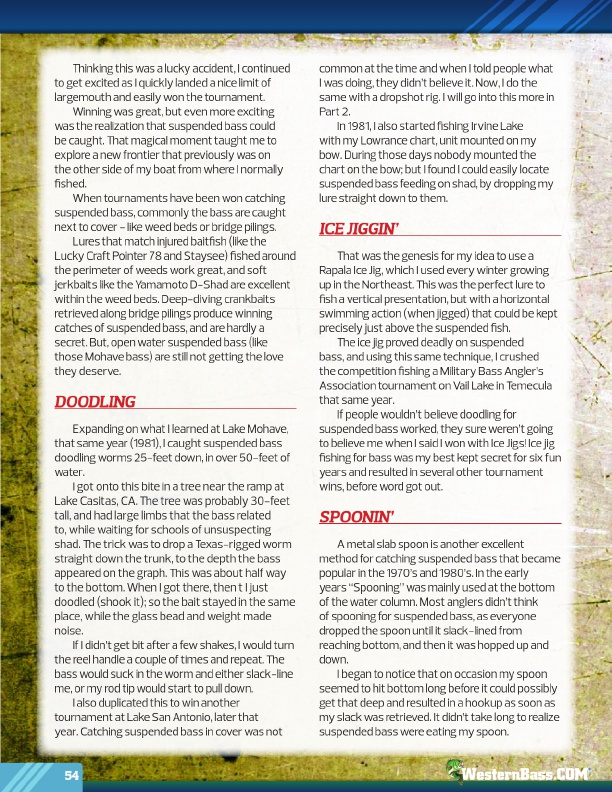
Thinking this was a lucky accident, I continued to get excited as I quickly landed a nice limit of largemouth and easily won the tournament.
Winning was great, but even more exciting was the realization that suspended bass could be caught. That magical moment taught me to explore a new frontier that previously was on the other side of my boat from where I normally fished.
When tournaments have been won catching suspended bass, commonly the bass are caught next to cover - like weed beds or bridge pilings.
Lures that match injured baitfish (like the Lucky Craft Pointer 78 and Staysee) fished around the perimeter of weeds work great, and soft jerkbaits like the Yamamoto D-Shad are excellent within the weed beds. Deep-diving crankbaits retrieved along bridge pilings produce winning catches of suspended bass, and are hardly a secret. But, open water suspended bass (like those Mohave bass) are still not getting the love they deserve.
DOODLING
Expanding on what I learned at Lake Mohave, that same year (1981), I caught suspended bass doodling worms 25-feet down, in over 50-feet of water.
I got onto this bite in a tree near the ramp at Lake Casitas, CA. The tree was probably 30-feet tall, and had large limbs that the bass related to, while waiting for schools of unsuspecting shad. The trick was to drop a Texas-rigged worm straight down the trunk, to the depth the bass appeared on the graph. This was about half way to the bottom. When I got there, then t I just doodled (shook it); so the bait stayed in the same place, while the glass bead and weight made noise.
If I didn’t get bit after a few shakes, I would turn the reel handle a couple of times and repeat. The bass would suck in the worm and either slack-line me, or my rod tip would start to pull down.
I also duplicated this to win another tournament at Lake San Antonio, later that year. Catching suspended bass in cover was not
common at the time and when I told people what I was doing, they didn’t believe it. Now, I do the same with a dropshot rig. I will go into this more in Part 2.
In 1981, I also started fishing Irvine Lake with my Lowrance chart, unit mounted on my bow. During those days nobody mounted the chart on the bow; but I found I could easily locate suspended bass feeding on shad, by dropping my lure straight down to them.
ICE JIGGIN’
That was the genesis for my idea to use a Rapala Ice Jig, which I used every winter growing up in the Northeast. This was the perfect lure to fish a vertical presentation, but with a horizontal swimming action (when jigged) that could be kept precisely just above the suspended fish.
The ice jig proved deadly on suspended bass, and using this same technique, I crushed the competition fishing a Military Bass Angler’s Association tournament on Vail Lake in Temecula that same year.
If people wouldn’t believe doodling for suspended bass worked, they sure weren’t going to believe me when I said I won with Ice Jigs! Ice jig fishing for bass was my best kept secret for six fun years and resulted in several other tournament wins, before word got out.
SPOONIN’
A metal slab spoon is another excellent method for catching suspended bass that became popular in the 1970’s and 1980’s. In the early years “Spooning” was mainly used at the bottom of the water column. Most anglers didn’t think of spooning for suspended bass, as everyone dropped the spoon until it slack-lined from reaching bottom, and then it was hopped up and down.
I began to notice that on occasion my spoon seemed to hit bottom long before it could possibly get that deep and resulted in a hookup as soon as my slack was retrieved. It didn’t take long to realize suspended bass were eating my spoon.
54 ®